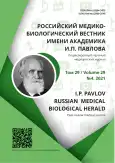现代放射测量人体内部温度检查在肿瘤学实践中的诊断能力研究
- 作者: Kulikov EP.1, Demko A.N.1,2, Volkov A.A.3, Budanov A.N.1,2, Orlova N.S.2
-
隶属关系:
- Ryazan State Medical University
- Ryazan Oncological Dispensary
- Moscow Regional Oncology Center
- 期: 卷 29, 编号 4 (2021)
- 页面: 531-538
- 栏目: Original study
- URL: https://bakhtiniada.ru/pavlovj/article/view/70596
- DOI: https://doi.org/10.17816/PAVLOVJ70596
- ID: 70596
如何引用文章
详细
论证:放射测量人体内部温度检查(RTM)是乳腺检查的一种实际方法。除了可视化病理病灶外,这种方法还可以评估代谢质量。从确定乳腺癌的生物学亚型和在免疫组织化学分析前评估肿瘤侵袭程度的可能性的角度来看,这是很重要的。
目的:探讨现代RTM在乳腺良、恶性病理鉴别诊断及各种生物学亚型乳腺癌中的应用价值。
材料与方法:我们使用计算机诊断系统RTM 01 RES对118例不同乳腺病理的患者进行了检查。测量在9个点进行:一个控制点在乳腺上观察肿瘤;两个控制点在胸骨上腹部和剑突处;一个控制点在两侧腋窝区以确定可能的转移。研究时间为每位女性15—20分钟。将RTM结果与组织学、超声、乳腺X线摄影及临床影像资料进行比较。
结果:RTM在乳腺病理鉴别诊断中的敏感性为96.9%,准确性为74.5%。RTM鉴别乳腺癌侵袭性亚型和非侵袭性亚型的特异性低,为6.6%。在评估病理组织和正常组织之间的温差时,与未受影响的组织相比,肿瘤组织的温差有增加的趋势。然而,健康乳房和受影响乳房的平均温度在统计上没有显著差异。乳腺癌增殖活性指数与热不对称频率及严重程度无相关性(r<0.3)。
结论:RTM在乳腺组织良恶性改变的鉴别诊断中已被证明是有效的。同时,它也不是评估乳腺癌患病率和生物亚型的首选方法。
关键词
作者简介
E Kulikov
Ryazan State Medical University
Email: rzgmu@rzgmu.ru
ORCID iD: 0000-0003-4926-6646
Researcher ID: S-1851-2016
MD, PhD, Professor, Head of the Department of Oncology
俄罗斯联邦, RyazanAnna Demko
Ryazan State Medical University; Ryazan Oncological Dispensary
Email: naetochka@yandex.ru
ORCID iD: 0000-0002-7941-5158
SPIN 代码: 2512-4630
Candidate of Medical Sciences, Assistant of the Department of Oncology, Oncologist of the Dispensary
俄罗斯联邦, 9, str. Vysokovoltnaya Ryazan, 3900262; 11, Dzerzhinskiy str, Ryazan, 390011Alexander Volkov
Moscow Regional Oncology Center
Email: aavolkov58rus@yandex.ru
ORCID iD: 0000-0003-0244-4951
SPIN 代码: 3668-6377
oncologist
俄罗斯联邦, 6 str. Karbysheva, Balashikha, 143900Andrey Budanov
Ryazan State Medical University; Ryazan Oncological Dispensary
Email: andrewbudanof@yandex.ru
ORCID iD: 0000-0002-8706-2655
Assistant of the Department of Oncology, Head. department of ultrasound diagnostics, oncologist
俄罗斯联邦, 9, str. Vysokovoltnaya Ryazan, 3900262; 11, Dzerzhinskiy str, Ryazan, 390011Nina Orlova
Ryazan Oncological Dispensary
编辑信件的主要联系方式.
Email: nina.orlova.6161@mail.ru
ORCID iD: 0000-0001-9934-9242
radiologist of the highest category
俄罗斯联邦, 11, Dzerzhinskiy str, Ryazan, 390011参考
- Vaninov A. S. Malignant neoplasms as the most priority medical and social issue of the healthcare system. Bulletin of Science and Practice. 2019;5(11):120–30. (In Russ). doi: 10.33619/2414-2948/48/16
- Kaprin AD, Rozhkova NI, editors. Rak molochnoy zhelezy. Moscow: GEOTAR-Media; 2018. (In Russ).
- Kaprin AD, Starinskiy VV, Petrova GV, editors. Sostoyaniye onkologicheskoy pomoshchi naseleniyu Rossii v 2016 godu. Moscow; 2017. (In Russ).
- Kovalenko MS, Koshulko PA, Korotkova NV. Catepsins as markers of malignant tumors of the mammary glands. Science of the young (Eruditio Juvenium). 2019;7(2):301–6. (In Russ). doi: 10.23888/HMJ201972301-306
- Burdina LM, Vaysblat AV, Vesnin SG, et al. Primeneniye radiotermometrii dlya diagnostiki raka molochnoy zhelezy. Mammologiya. 1998;(2):3–12. (In Russ).
- Vesnin SG, Klapan MA, Avasyan RS. Contemporary microwave radiothermometry of mammary glands. Tumors of Female Reproductive System. 2008;(3):28–33. (In Russ). doi: 10.17650/1994-4098-2008-0-3-28-33
- Sdvizhkov AM, Vesnin SG, Kartasheva AF, et al. O meste radiotermometrii v mammologicheskoy praktike. In: Aktual’nyye problemy mammologii. Moscow; 2000. P. 28–40. (In Russ).
- Vepkhvadze RYa, Lalashvili KYa, Kapanadze BB. Mashinnaya termodiagnostika opukholevykh protsessov molochnykh zhelez. In: Teplovideniye v meditsine. Leningrad; 1990. (In Russ).
- Vidyukov VI, Mustafin CK, Kerimov RA, et al. Differential diagnosis of breast tumors on the basis of radiothermometric findings. Tumors of the Female Reproductive System. 2016;12(1):26–31. (In Russ). doi: 10.17650/1994-4098-2016-12-1-26-31
- Napalkov NP. Osnovnyye napravleniya i perspektivy primeneniya termografii v klinicheskoy onkologii. In: Teplovideniye v meditsine. Leningrad; 1990. (In Russ).
- Semiglazov VF. Skrining raka molochnoy zhelezy. In: VIII Rossiyskiy onkologicheskiy kongress. Moscow; 2004. (In Russ).
- Sinelnikova OA, Kerimov RA, Sinyukova GT. Microwave radiothermometry in the evaluation of the efficiency of meoadjuvant treatment for breast cancer. Onkoginekologiya. 2014;(2):55–66. (In Russ).
- Burdina LM, Khaylenko VA, Kizhayev EV, et al. Primeneniye radiotermometra diagnosticheskogo komp’yuterizirovannogo integral’noy glubinnoy temperatury tkani dlya diagnostiki raka molochnoy zhelezy. Moscow; 1999. (In Russ).
- Barrett A, Myers PC, Sadowsky NL. Detection of breast cancer by microwave radiometre. Radio Science. 1977;12(6S):167–71. doi: 10.1029/RS012I06SP00167
- Cockburn W. Breast Thermal Imaging, the Paradigm Shift. Dynamic Chiropractic. 1995;13(01)
- Kerimov RA, Kochoyan TM. Ultrahighfrequency radiothermometry (UHF-RTM) in oncomammology (concise literature review). Onkoginekologiya. 2017;(1):19–26. (In Russ).
- Gautherie M, Gros CM. Breast Thermography and Cancer Risk Prediction. Cancer. 1980;45:51–6.
- Gautherie M, Gros С. Contribution of infrared thermography to early diagnosis, pretherapeutic prognosis, and post-irradiation follow-upof breast carcinomas. Medicamundi. 2006;21:135.
- Omranipour R, Kazemian A, Alipour S, et al. Comparison of the accuracy of thermography and mammography in the detection of breast cancer. Breast Care. 2016;11(4):260–4. doi: 10.1159/000448347
- Gautherie M, Haehnel P, Walter JP. Thermobiologic evaluation of benign and malignant breast diseases. Geburtshilfe und Frauenheilkunde. 1985;45(1):22–8. doi: 10.1055/s-2008-1036200
- Moiseyenko VM, Semiglazov VF. Kineticheskiye osobennosti rosta raka molochnoy zhelezy i ikh znacheniye dlya rannego vyyavleniya opukholi. Mammologiya. 1997;(3):3–12. (In Russ)
- Lawson RN, Gaston JP. Temperature measurements of localized pathological processes. Annals of the New York Academy of Sciences. 1964;121:90–8. doi: 10.1111/j.1749-6632.1964.tb13688.x
- Vesnin S, Turnbull AK, Dixon JM, et al. Modern Microwave Thermometry for Breast Cancer. MCB Molecular and Cellular Biomechanics. 2017;7(2):1–6. (In Russ). doi: 10.4172/2155-9937.1000136
- Demko AN, Kulikov EP, Budanov AN, et al. Termoassimetricheskiye osobennosti patologii molochnoy zhelezy. In: Tezisy X S”yezda onkologov Rossii, Nizhniy Novgorod, 17–19 April 2019. Moscow: Meditsinskoye Marketingovoye Agentstvo; 2019. P. 37–38. (In Russ)
- Volkov AA, Demko AN, Korobova IM, et al. Effektivnost’ radiotermometrii pri razlichnykh biologicheskikh podtipakh raka molochnoy zhelezy. Evraziyskiy onkologicheskiy zhurnal. Tezisy XI S”yezda onkologov i radiologov stran SNG i Evrazii. 2020;8(2S):391. (In Russ)
补充文件








